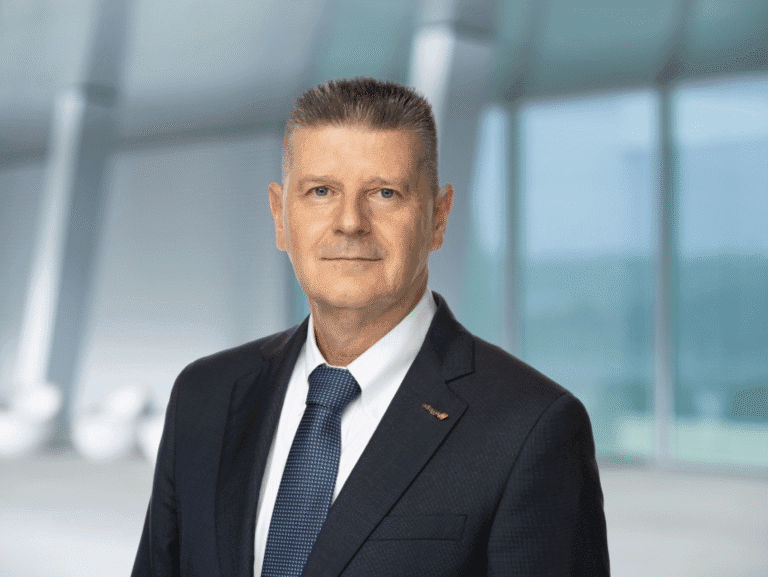- Swissport is strengthening resilience through AI-driven forecasting, automated handling systems, and CEIV Pharma-certified facilities, ensuring real-time control and agility across complex cargo networks.
- Digitalisation and automation on the warehouse floor — from Cargospot Neo to smart devices and autonomous vehicles — are transforming visibility, efficiency, and safety while cutting bottlenecks and boosting service reliability.
- Sustainability and workforce empowerment drive long-term progress, with around €1.5 billion investment over five years in capital infrastructure, which includes ground support equipment (GSE), and other investments in innovative and eco-friendly technology – all backed by ISO certifications and a people-first culture that blends technology with human expertise.”
Behind every aircraft turnaround and pallet of airfreight, digitalisation, automation, and workforce renewal is reshaping operations, as companies work to stay resilient in the face of supply chain shocks, labour shortages, and growing pressure to cut emissions
“Resilience today is about anticipating disruption, not just reacting to it,” Dirk Goovaerts, Swissport’s CEO Continental Europe, Middle East, Africa, India, and Global Cargo Chair, said. “Our flexibility to reroute flows quickly when regional disruptions occur, supported by CEIV Pharma-certified facilities and AI-driven forecasting, gives us real-time control over complex supply chains.”
This data-led approach is increasingly critical as cargo networks become more fragmented. Advanced systems such as Cargospot Neo and predictive AI tools now allow ground handlers to optimise manpower, automate repetitive tasks, and maintain service quality during volume spikes.
“Innovation is our resilience engine,” Goovaerts adds. “At our labs, we’re testing automated material handling systems and digital platforms that absorb sudden volume surges with agility. But none of it works without people who are trained and confident to handle pressure.”
Tools for safety-critical tasks, along with new operational competence assessments, are changing how frontline teams prepare for disruption. “It’s that combination of infrastructure, technology, and people that ensures continuity and quality even under the toughest conditions,” he says.
Digitalisation on the warehouse floor
As airfreight volumes rise and shipment types diversify, efficiency increasingly depends on instant data sharing between handlers, airlines, and forwarders.
“Digitalisation and data sharing are becoming the backbone of efficient cargo handling,” Goovaerts explains. Across dozens of warehouses, mobile devices, smart weighing systems, and API-connected management platforms are replacing paper-based processes with live operational visibility.
“Cargospot Neo delivers efficiency through intelligent automation, dynamic task allocation, and seamless connectivity with our airline and forwarder partners,” he notes.
That visibility extends to customers, too. Truck drivers can now reserve time slots via self-service kiosks, easing congestion at terminal gates, while customer portals provide live tracking and performance dashboards. “These innovations keep us ahead of the curve, delivering transparency, speed, and reliability across the network,” Goovaerts says.
Automation, robotics, and AI are steadily reshaping the warehouse environment. Autonomous guided vehicles and robotic tugs reduce manual cargo transport, while high-density racking and digital twin simulations help planners model future workflows. “AI helps forecast flight delays and resource needs before they happen,” Goovaerts says. “That predictive power means fewer bottlenecks, better safety, and faster turnaround times.”
Sustainability and human skills
While automation defines the next chapter of cargo handling, sustainability and workforce development remain its foundation. “Decarbonisation is central to our long-term strategy,” Goovaerts stresses. “We’ve committed €1.5 billion over five years to upgrade infrastructure, electrify fleets, and embed sustainability into operations. By 2032, 55 percent of our ground equipment will be electric.”
Green operations are becoming a performance metric of their own. Facilities in Barcelona, Madrid, and the UK are already powered by renewables, while solar energy supports warehouses in Frankfurt and Nairobi. “Our ESG framework includes a 51 percent reduction in Scope 1 and 2 emissions by 2032, and 100 percent certification under ISO 14001 and 45001,” he says.
Yet Goovaerts insists that true transformation depends on people. More than 25,000 employees are trained each year through digital and safety programmes designed to equip them for an increasingly automated environment. “Technology should support our highly skilled teams, not replace them,” he says.
His “Six Red Rules” set standards for fair pay, predictable rosters, safe rest areas, and equitable workloads — principles that keep morale high and operations safe. “Automation complements these efforts by removing repetitive tasks, reducing strain, and letting people focus on safety and service quality,” he adds.
Collaborating towards the future
The future of ground handling lies in deeper industry collaboration. “Air cargo is a community-driven business. The best results come when all participants — airlines, handlers, airports, and forwarders — come together at one table,” he says.
Across Europe, Africa, and Asia, handlers are joining forces with partners to create specialised corridors for flowers, pharmaceuticals, and e-commerce. “These partnerships drive efficiency, reliability, and shared innovation throughout the supply chain,” Goovaerts explains.
Looking ahead, he sees the next-generation terminal as both smarter and more human. “Automation, sustainability, and customer-centric design will define the future of ground handling,” he concludes. “But just as important are the teams who make it work. By combining cutting-edge technology with well-trained, motivated people, we can build operations that are not only efficient and green but also safer, more transparent, and ultimately more human-centred.”




